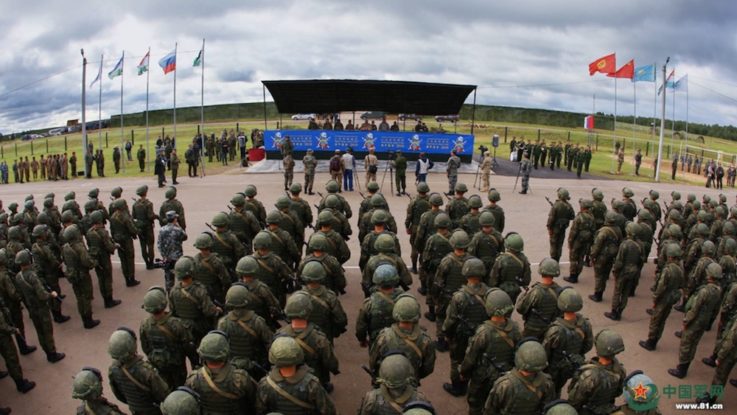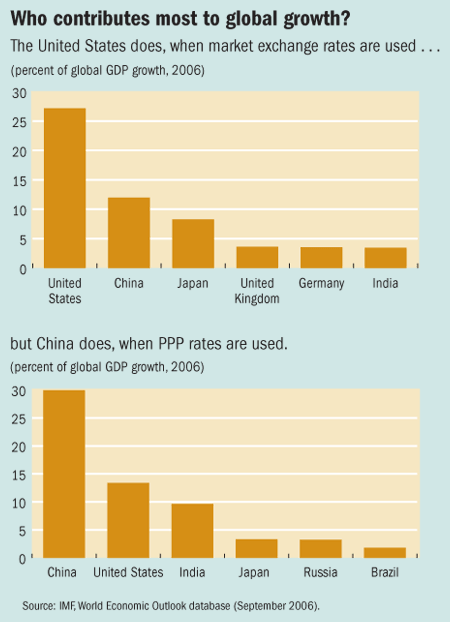
The debate over American relative decline can get pretty complicated. You can’t really sum the components of state power into some kind of aggregate, “total power” measure. Even if you could, it’s not clear how you would create a metric that includes the different instruments associated with economic, military, diplomatic, and other capabilities.
One effort in political science, the CINC (Composite Indicator of National Capability) index, comes with the following disclaimer:
Values for total population, urban population, iron and steel production, energy consumption, military personnel, and military expenditure for each state-year were originally collected to construct the composite index of national capabilities. These components are offered here but the user of these data should be warned that the quality and quantity of the data vary greatly from state to state and from year to year. In particular, each of the six indicators has its own idiosyncrasies that limit cross-time comparability. Hence, those who use the raw data in time-series analyses should do so with caution.
While none of the components of a CINC score are unreasonable, it seems unlikely that putting them together really describes a state’s total national power.
In everyday policy discussions, authors are most likely to look at Gross Domestic Product (GDP) – sometimes in nominal terms, sometimes adjusted by purchasing power parity – to proxy for economic power and military spending to proxy for military capabilities.
Putting aside measurement issues with GDP in general, and PPP adjustments in particular, whether you use nominal or PPP gives a rather different picture of the largest players in the global economy.

While both trends in nominal and PPP GDP show a rising China, they also provide a different picture of relative economic power.


Of course, GDP is an imperfect proxy for global economic power. Global economic influence depends not simply on how rich a country is, but many other factors, including the value of its consumer market, how much money its government has to “throw around” in international affairs, and asymmetries in influence generated by patterns in interdependence.
Military spending is, if anything, a more problematic proxy. Both variants of GDP suffer from measurement problems, including the fact that many countries supply falsified or inaccurate data. Military spending is, in some ways, less transparent. It is also a pretty indirect measure of the strength of the military instruments that a state has at its potential. The technological characteristics of those instruments, the combat readiness of military forces, how specific portfolios of capabilities interact, logistics, and a host of other factors shape military power. Military power also has a symbolic dimension – which matters, given that a lot of the power-political “work” done by military instruments has little to do with actual combat operations.
Michael Beckley has devoted substantial attention to the question of whether the rise of China is really undermining America’s status as a unipolar power. He is skeptical for a lot of reasons, including the fact that a good chunk of aggregate Chinese military spending goes toward domestic security rather than developing capabilities mainly intended for use against foreign adversaries.
Enter Daniel Bessner’s new piece at Prospect, where he also argues that American dominance is going to be around for some time.
And it is true that Trump is widely distrusted throughout the world. In the United Kingdom, only 32 per cent of those polled believe Trump will “do the right thing regarding world affairs;” in France and Germany that number falls to 20 per cent and 13 per cent, respectively; in Mexico, it’s only 8 per cent. Trump is also among the least trusted of world leaders, with 64 per cent of people polled in over 30 countries expressing “no confidence” in the president.
But, fortunately for advocates of “world leadership” like Susan Rice, American hegemony has very little to do with trust and espoused values and far more to do with actual and potential martial capabilities. The United States is by far the world’s dominant military power and will likely remain so for years to come. It is this material might—not “soft power,” not the export of US culture, and not global faith in US leaders—that is the base upon which US hegemony rests.
As such, despite the hit that the United States’ public image has taken in the era of Trump, contemporary talk of American decline is far overblown. Though Boris Johnson, Emmanuel Macron, and Justin Trudeau might mock Trump for his unpredictability (as they did in an early December meeting at Buckingham Palace), neither the United Kingdom, nor France, nor Canada has the power or will to break with the United States on any major issue. In the final analysis, Trump’s presidency reveals that the United States can be led by a despised fool, and that this simply doesn’t matter very much for America’s global position.
This is a serious problem for leftists and liberals alike. Even if one believed that the United States acted as a force for good and stability during the Cold War—which is doubtful, especially when one considers the disastrous effects of US intervention in Iran, Guatemala, Vietnam, Chile, and elsewhere—it is abundantly clear from the last two decades of meddling in the Middle East that the world can’t afford to be dominated by Americans. The question then becomes how to challenge US global “leadership”—or what might more accurately be termed US empire. The only way to develop a satisfactory answer to this query is to confront the sheer power of the United States head on. Simply put, pretending that the nation is in decline will do little but provide succour to those who want to maintain an unchallenged American hegemony.
As we argue in passing in Exit from Hegemony, and I’ve elaborated in a number of academic articles, I’m not convinced that American leadership – which is just a less technical way of saying “hegemony” – is a euphemism for “empire”. It’s better to think of hegemony as a generic term for, as Alexander Barder puts it, the “mobilization of leadership” or, alternatively, a situation in which a political community uses its superior capabilities to order relations among other political communities.
That order can be more or less imperial – even with the same hegemonic system. It makes little sense, for example, to characterize contemporary American relations with its European allies, with Japan, let alone with China or India, in terms of “empire.” Washington doesn’t currently exercise either indirect or direct rule over any of those states. But there are plenty of times and places where “informal empire” describes not only the structure, but also the dynamics of relations between the United States and its clients.
This might seem like something of a semantic argument among academics, but it does matter to our understanding of “American decline”. Bessner is absolutely correct that American remains a military juggernaut, and that this allows the United States to use force and project power into regions like the Middle East.
At the same time, the rise of other states does have effects on U.S. military dominance. Russia has made itself a player in the military balance in the Middle East; there’s not a lot the United States can do about that without incurring unacceptable risks.
Yes, China’s overseas basing and access agreements barely registered when compared to the American overseas network. But China is only at the very beginning of its effort to develop the political infrastructure for power projection, and it is capable of engaging in some limited overseas operations. When it comes to conventional military strength, we simply don’t know how effective China would be at blocking US power projection into East Asia in the event of a military conflict. What we do know is that China is better positioned to do so than it was ten years ago, and that it continues to improve its war-fighting capabilities.
Still, Alex and I do not doubt that the United States is capable of remaining – and likely to remain – a global power. It may have many years left as the only truly worldwide military powerhouse. Our position is best understood as “neo-declinist”: American hegemony is unravelling because Washington has lost, or is losing, its temporary monopoly on the tools of international ordering: development assistance, credible security guarantees, and the provision of other international goods.
As we write in the conclusion, “the United States will no longer be able to exercise global hegemony, and that it will need to accommodate other powers to a much greater extent than it is used to.” This is because shifting economic and political power leave the United States unable to order – at least worldwide – relations among and within states with anything close to the degree that it could in the 1990s and early 2000s.
We’re seeing this unfold in increasingly effective contestation over international rules and norms, and in a rapidly expanding “alternative order” composed of institutions like the Shanghai Cooperation Organization, the New Development Bank, and the Asian Infrastructure Investment Bank. We show in the book that the last 10-15 years has seen a startling increase in joint-affiliation ties – common membership in international institutions and fora – between China, and to a lesser extent Russia, and other countries.
Critics like Bessner are correct to puncture the panglossian image of a benevolent “rules based order” led by a selfless United States. Washington has a lot of answer for, and not just with respect to the examples that Bessner provides. But it is also difficult to deny the unusual – and often liberal – features of international order. As I like to point out, international order doesn’t look very liberal when compared to its own pretensions. But it looks extremely liberal when compared to other international orders – more favorable towards human rights, democracy, and social welfare, while less tolerant of the use of military force, annexation, and imperialism. It is also not at all clear that the current trajectory of international order will be an improvement, especially given the rising tide of reactionary, authoritarian, and kleptocratic forces.
In fact, the combination of declining non-military instruments of leadership and continuing military dominance could prove particularly toxic, as it will leave the United States more dependent on threats to use force – and the actual use of force – to pursue its interests. This is the danger Stephen Wertheim identified when he pointed out that Trumpism isn’t about pulling back from the world, but about greater American militarism.
There’s nothing wrong with trying to conserve and enhance U.S. influence, and with attempting to shape international order in ways more favorable for the progressive project. Doing so is compatible with getting control over ginormous U.S. military budgets. But we also cannot ignore the fact that American relative power is in decline and Washington’s ability to order international affairs is eroding. Power is about more than military spending, and hegemony is about more than blowing stuff up.

